Orangutan: The Man of the Forest
By Irina Bright
What exactly makes us feel so mesmerized with the orangutan - the only great ape living in Asia?
This article is part of our Environment section
See the complete list of all our Articles about Rainforest Animals here.
That the Orangutan is an animal of the human form, inside as well as outside: That he has the human intelligence, as much as can be expected in an animal living without civility or arts: That he has a disposition of mind, mild, docile, and humane: That he has the sentiments and affections peculiar to our species, such as the sense of modesty, of honour, and of justice; and likewise an attachment of love and friendship to one individual, so strong in some instances, that the one friend will not survive the other.
~ Lord Monboddo, 1774 (Ref. 1)
Contents
 © Leo Reynolds
© Leo Reynolds
Overview
Man of the Forest
Physical AppearanceHabitat
Food
Everyday Life
Reproduction & Lifespan
As Part of Rainforest Ecosystem
As a Semi-Social Animal
Social Interactions with HumansAs an Intelligent Animal
Self-AwarenessPlanning Ability
Tool Use
Language
Imitation
As an Endangered Animal
Conclusion
References
___Overview
Like Scottish Lord Monboddo had said back in 1774, this highly intelligent animal is very similar to our own species, in so many different ways which until today we may not even have fully grasped.
Famous Swedish zoologist of the 18th century Carl Linnaeus admitted that he "could not discover the difference between man and the orangutan ...". (Ref. 2)
German philosopher Immanuel Kant even went as far as to suggest that:
"It is possible for a chimpanzee or an orangutan, by perfecting its organs, to change at some future date into a human being. Radical alterations in natural conditions may force the ape to walk upright, accustom its hands to the use of tools, and learn to talk." (Ref. 3)
When we look into the orangutan's eyes, what is it that we see?
Can we see ourselves with all the complexity of our own feelings and emotions?
Or is it our often ignored relationship with the Earth, the planet that we so depend upon for our own survival?
Or perhaps the history of human origins that is being related to us through the contact with these beautiful rainforest animals?
Whatever your answers to these questions may be, one thing is clear - inescapably, we feel very close to them.
In fact, this similarity to the human race gave rise to this animal's name - in Malay, orangutan means "the man of the forest".
The Man of the Forest
Orangutans are the only Asian great apes. All other great apes - gorillas, chimpanzees and bonobos - live in Africa.
Orangutans are arboreal animals, i.e. they live in trees.
They are divided into two species - Bornean species and Sumatran species.
They live respectively in the tropical islands of Borneo (shared by Malaysia, Indonesia and Brunei) and Sumatra (Indonesia) which provide them with their vital rainforest habitats.
Physical Appearance
The most striking feature of the orangutan's physical appearance is perhaps its characteristic orange red brownish hair which distinguishes it from other black- and brown- haired great apes.
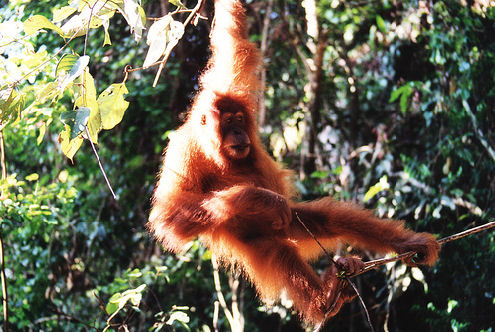 © Nick Leonard
© Nick Leonard
That is why he is sometimes called the red ape.
Adult males and older adult females may have bare backs but the hair on a male can be very long and look like a cape. (Ref. 4)
Next to gorillas, orangutans are the largest of the great apes. (Ref. 5)
Adult males are normally twice the size of females (ref. 6) and may be as tall as 175 centimeters and weigh over 118 kg, while adult females may reach a height of 127 centimeters and weigh around 45 kg. (Ref. 7)
Their arms are twice as long as their legs (ref. 8). In fact, their arms are proportionately the longest of those of all the great apes (ref. 9).
Their feet look and function like hands; and fingers and toes are curved which allows them to grip firmer onto the trees' branches. (Ref. 10)
Also, thanks to the unique structure of their hip joints, these animals have much less restriction in the movement of their legs than other primates. (Ref. 11)
This flexibility in the movement of legs and arms is the orangutans' adaptation to tree-dwelling.
They are not true knuckle-walkers like gorillas but instead "walk" on the ground on all four limbs, by leaning on the backs of their palms with their fingers curved inwards (ref. 12); this type of walk is also called fist-walking.
Among other features, sexually mature adult males have prominent cheek pads ("flanges" that can be very impressive indeed!), throat pouch and long fur which are absent from sexually immature subadult males and adult females. (Ref. 13)
In general, these animals are incredibly strong creatures - they are about four times as strong as human beings. (Ref. 14)
A curious episode took place some time ago in Malaysia when an orangutan grabbed a French tourist and stripped him of all his possessions, including clothes, before finally letting him go! (Ref. 15)
Habitat
Like we mentioned above, the orangutan lives exclusively in two islands in Asia - Borneo and Sumatra which are endowed with rainforests.
Bornean orangutans occupy almost all forested habitat of Borneo (ref. 16), and Sumatran orangutans live in the northern part of Sumatra.
These rainforest animals depend on trees like no other great apes, where they spend nearly all of their time.
They are currently the largest living arboreal animals in the world. (Ref. 17)
The historical reason for their tree-dwelling may have been their need to escape their natural predators - tigers and leopards - living on the ground. (Ref. 18)
But now since tigers are extinct in Borneo, Bornean orangutans may occasionally venture down, presumably to move from one stand of trees to another. (Ref. 19)
However, this problem persists in Sumatra where Sumatran orangutans are still actively threatened by tigers as well as clouded leopards, hunting dogs and crocodiles.
This is probably the reason why Sumatran orangutans are seen on the ground a lot less often that their Bornean relatives. (Ref. 20)
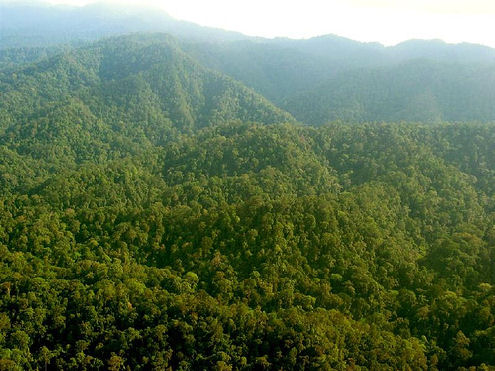 Tropical Rainforest, Sumatra
Tropical Rainforest, Sumatra© Neil Franklin
Orangutans live in the tropical rainforest canopy, as high as 7 to 30 meters above the ground. (Ref. 21)
Bornean orangutans prefer peat swamp forests and lowland dipterocarp forests (ref. 22) which are biodiversity-rich and provide these animals with all their dietary needs.
They are normally not found in forests at elevations above 1.000 m. (Ref. 23)
Just like the Bornean species, Sumatran orangutans' primary habitats are peat swamp forests and dipterocarp forests. (Ref. 24)
Unlike the Bornean species though, Sumatran orangutans can be found at elevations up to 1.500 m. (Ref. 25)
Though there is plenty of water in their habitats, orangutans cannot swim but can be taught to do so. (Ref. 26)
Tropical rainforests are, of course, fantastic habitats for orangutans.
Warm climate with lots of moisture throughout the year produce plentiful (albeit irregular) supplies of food for tropical wildlife.
Food
Orangutans' main diet is ripe fruit.
They consume more than 400 different types of foods (ref. 27) as well as buds, flowers, young leaves, bark, vines, orchids, bird eggs, spider webs, ants etc. (Ref. 28)
That said, foods such as bark are only consumed as a last resort in case of seasonal unavailability of fruits. (Ref. 29)
Among some of the fruits that orangutans eat are rambutans, jackfruits, mangosteens, mangoes, figs.
Out of all fruits though, it is the durian fruit which they absolutely love. (Ref. 30) This fruit is supposed to have a very strange taste and a very strong odor. Apparently, it is even prohibited in some public transport systems in Southeast Asia!
In the wild, orangutans are known to engorge themselves on fruit when it is available; this allows them to put on additional fat stores to be used in less abundant times.
(Ref. 31)
Quite interestingly, they were even observed to eat soil or rock, mainly for 3 reasons: to get additional minerals to their diet, to get the clay minerals which can absorb toxic substances, and to treat a disorder such as diarrhea. (Ref. 32)
Everyday Life (Ref. 33)
Obviously, orangutans spend most of their time up in the trees where they feel most comfortable.
If you watch orangutans swing from one branch to another, you'll be totally amazed at the beauty and grace of their movements!
However, male orangutans may often be too heavy to travel in the higher, thinner branches. That may be why they travel on the ground more often than their female counterparts.
So just how far do orangutans travel?
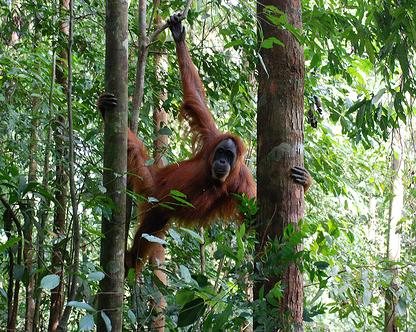 © Seb Ruiz
© Seb Ruiz
Home ranges of female and male orangutans are significantly different.
The home range of Bornean females inhabiting peat and lowland swamp forests of this island, is between 3.5 and 6 km2.
The home range of Sumatran females, on the other hand, is more extensive and is closer to 8.5 km2.
The reason for that may be the fact that Sumatran orangutans inhabit higher elevations which are not as bio diverse as the Bornean forests, and these animals have to travel longer distances to find food.
In general, home ranges of males of both species are considered to be several times larger than those of females.
Home ranges of males and females may often overlap with each other.
Orangutans' main activities during the day are feeding and resting as well as moving between feeding and resting sites.
After waking up in the morning, orangutans spend several hours feeding, then build their sleeping nests for a midday nap and rest.
They travel more during the afternoon hours and prepare their nests again - this time for their night sleep.
Young orangutans will normally sleep in their mothers' nest until they become more independent.
Sometimes orangutans will sleep in their old nests.
Reproduction and Lifespan (Ref. 34)
The reproduction process of orangutans is similar to that of humans in many ways.
The process of sexual maturity in wild female orangutans may start between the age of 6 and 11 years, but they become fully mature by the age of 14 and 15 when, after the gestation period of around 9 months, they will usually give birth to their first child.
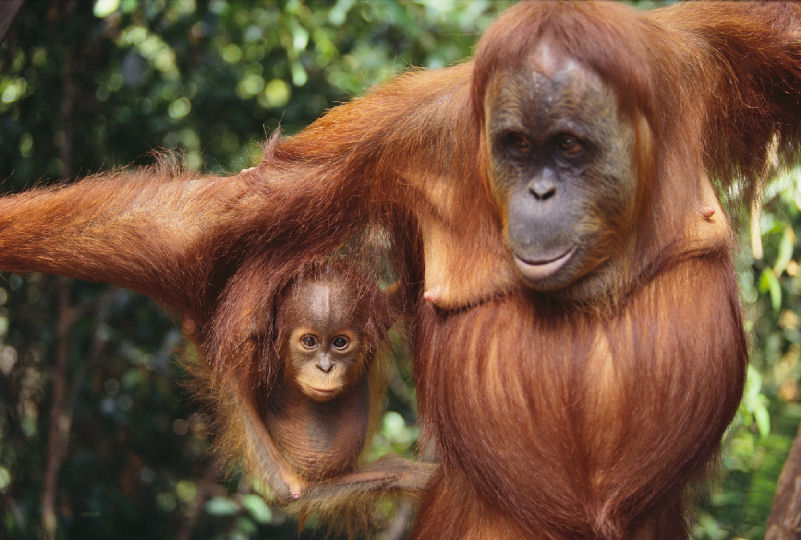
Sexual maturity in males occurs between 8 and 15 years of age.
Intervals between each birth for female orangutans are around 8 years, which is the longest period among all great apes.
When they are born, infants weigh less than 1.5 kg and have prominent white / pink patches around their eyes and mouths as well as in other areas of their bodies; as they age, their skin will become dark brown or almost black.
Mortality rates in the wild are very low; it may be because mothers take extremely good care of their infants.
Mothers carry their infants constantly for the first year, and then during travel until the of age 4.
Young orangutans stay with their mothers until they are 8 - 10 years old, when they become fully independent.
Orangutans live between 50 and 60 years in the wild.
Orangutan as Part of Rainforest Ecosystem
Indeed, we should never underestimate the importance of orangutans within the rainforest ecosystem that they call home.
These animals are so valuable to the well-being of many other rainforest plant and animal species that they are considered to be a keystone species: a species which has a disproportionately large effect on other living beings that it co-exists with.
Like we've seen above, orangutans consume an enormous amount of fruits whose seeds they subsequently disperse throughout the forest.
Many of these fruits and other plants - which are also crucial components of the rainforest - depend on orangutans for the dispersal of their seeds.
This is especially true for the large seeds that are not dispersed by smaller animals.
(Ref. 35)
For some species, such as Strychnos ignatia which contains some toxic elements, orangutans are the only dispersers. (Ref. 36)
Because orangutans are such efficient dispersers of seeds, they are sometimes called "gardeners of the forest".
Orangutan as a Semi-Social Animal (Ref. 37)
Though orangutans are considered to be more solitary than any other ape species (ref. 38), there are still many ways in which they can express and realize their social needs.
These animals have a very interesting social structure which is certainly worth a look at.
Their society seems to be working as follows.
Young, subadult males and females may travel together in small groups until their adulthood. At this stage, they don't have their own home ranges.
Resident (or adult) females and their infants and juveniles do have their own home ranges.
The ranges of adult females (that may actually be relatives) overlap each other.
When they meet, adult females can be both aggressive or friendly.
Home ranges of females usually fall within the home range of an adult male with whom these females mate.
A resident male is the one that has his own home range which may overlap the ranges of several adult females.
Home ranges of adult males may also overlap, and when they meet, their behavior is aggressive towards one another.
 © Nick Leonard
© Nick Leonard
You really cannot miss an adult male when you see one!
Adult males have prominent cheek pads called flanges.
They are referred to as secondary sexual characteristics because they develop as a result of increased levels of testosterone in adult males.
Alongside flanges, adult males also have a throat pouch which they use for making long calls to attract females.
These calls can be very loud and can be heard as far as 2km away.
Because the home ranges of resident adult males and adult females overlap, they have frequent general encounters and brief social interactions.
There are also non-resident males (both subadult and adult) and females that may range either alone or in small groups.
In general, there are several situations in which orangutans socialization can take place.
The first situation is socialization for mating purposes.
For these purposes, the animals form a consortship group of several individuals that stay together for several days or weeks. This group normally consists of the breeding pair and the female's infant or juvenile.
An adult male makes a long call to attract females and discourage other males.
Interested females then use it as a tool to track this adult male and make their way to his location.
So if females prefer to mate with adult males, what happens to subadult males (the ones that lack the cheek pads)?
Can they reproduce at all?
The answer is yes they can, but it happens against the wishes of females.
Subadult males find immature females (who cannot physically resist these males' advances) and force copulation - that is how they father their own children.
Once subadult males are able to establish and protect their own territories, they are transformed into adults with cheek pads developing within the next few months of this transition. (Ref. 39)
The second situation is mothers taking care of their infants and guiding them until they become fully independent.
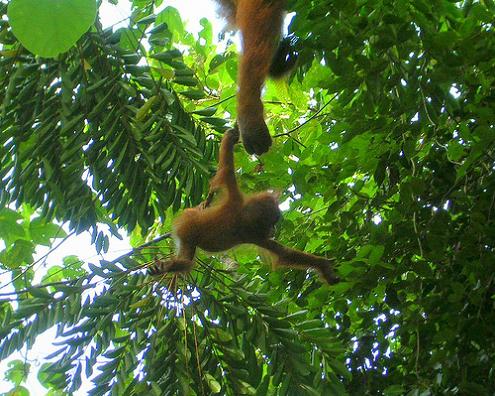 Learning to Swing!
Learning to Swing! © elbisreverri
Since males do not contribute anything to bringing up their offspring, this burden lies fully on mothers' shoulders.
The mother and her infant share the strongest social bond possible in orangutans' society, with the infant totally depending on his mother for all his needs in the first several years of life.
There is an amazing amount of physical contact between these two, especially during the child's first year from birth when the mother almost constantly carries him and sleeps with him in her own nest.
By the age of two, the child acquires climbing and swinging skills, and the mother can now walk with him by holding his hand.
As the child grows, the mother allows him to take exploratory trips on his own, and teaches him to build his own nests and choose the right types of foods.
The mother will usually have more than one offspring with her - this will also allow the growing child to socialize with his older siblings.
After about the age of five, the newly developed adolescent will seek more communication and travel with his peer groups, and will ultimately become independent by the age of 8.
The third situation is so called feeding aggregations.
Feeding aggregations take place when orangutans get together and consume fruits on large trees.
This form of socialization becomes possible when there is an abundant supply of fruits and there is no competition for resources.
One of the reasons why Sumatran orangutans are more social than their Bornean counterparts is because of the higher productivity of Sumatran habitats; so they don't have to compete with each other, and instead they socialize.
The fourth situation is travel bands which are formed by individuals feeding and traveling together between food sources during the times of fruit abundance.
These are usually consortship groups consisting of a male and a female as well as the female's offspring.
Social Interactions of Orangutans and Humans
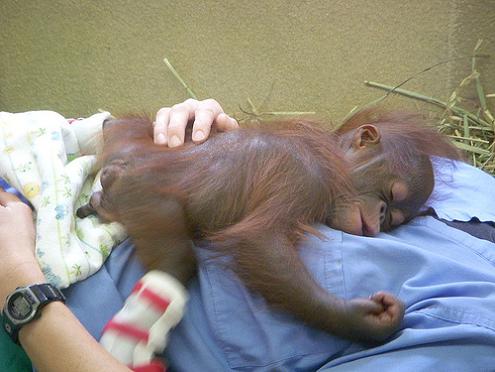 Photo: Flickr.com
Photo: Flickr.com
Orangutans have of course generated an incredible amount of interest around the world, and now there is a lot more social contact between these animals and humans who are eager to come and visit them in the wild.
They are known as placid and unaggressive animals that are rarely dangerous to humans with whom they normally avoid contact in the wild. (Ref. 40)
Here is how actress Julia Roberts describes her own meeting with a male orangutan in Borneo: (Ref. 41)
Held tight in the powerful hands of a 20-stone orang-utan - an alpha male ape who thought I was a doll - I was justifiably terrified.
But then I relaxed - somehow I felt I could trust him. I was in Borneo, one of the chain of islands that make up Indonesia. Somewhere in its vast, tropical rainforest I had come face to face with the increasingly rare orang-utan - a creature that lives very much as our ancestors did, a reminder of our prehistoric past.
He's enormous and I was scared. He seemed oblivious to my presence, and I was convinced he wasn't interested in me. We sat together on the path and when he finished eating an apple he came closer. I was still nervous because he's so huge, and the closer he got to me, the smaller I felt. He had quite a long beard and was a little smelly.
He reached out to me, but I knew instinctively-that he didn't want to hurt me. He wanted to play as though I was a doll, or carry me off and have a smooch. He got me in a strong grasp and wouldn't let go. It got a bit out of hand, but I knew his intentions were playful and so I think that he paid me a compliment.
His hands are enormous, they are the size of my head, and he has the strength of an entire person's body in one finger. He could have crushed me with his weight, the equivalent of three of me. It was scary, because I didn't know where it was going, but not as scary as being mugged in my home town, New York, from where I had gone to Pangkalanbuun, a hip little town in southern Borneo, the last piece of civilisation before I headed off into the jungle.
We have also heard of some truly fascinating twists in the human - orangutan relationship.
Birute Galdikas, the world's most respected authority on orangutans, describes the following situation: (Ref. 42)
I had a student in 1978, Gary Shapiro, who came to Camp Leakey and he taught an adult female, Rinnie, sign language. He could not believe how fast she learned it. Rinnie took the tutoring personally. One day, Rinnie took Gary by the hand and tried to seduce him. Gary pushed her away. She thereafter lost all interest in signing.
See, we are not the only ones to think that orangutans are like us.
It looks like orangutans think that we are very much like them as well!
Orangutan as an Intelligent Animal
Orangutans look and behave so much like us that, naturally, we want to learn as much as possible about these beautiful creatures.
How do orangutans think?
What is on their minds?
Can they copy each other's actions?
Can they plan ahead?
Can they use tools to achieve better results?
Are they able to learn and use language to communicate with each other, and with humans?
Are they able to teach their children different skills for their future lives?
Self-awareness
Guided by the fact that self-awareness is an indicator of a certain level of intelligence, researchers usually use a mirror test as an instrument to understand whether animals are aware of themselves.
Orangutans have passed this test.
First, they are given a chance to get used to mirrors and seeing their own reflections in them.
Their faces are then marked with paint and they are given mirrors again to see if they find something unusual on their faces, which they do.
Right after noticing paint spots on their faces, they immediately reach and touch them, just like we do. (Ref. 43)
This means that they are aware of their own presence.
So why do we use self-awareness as a measure of intelligence?
We do so because we assume that animals that are aware of themselves may also have a better, more conscious understanding of the world around them.
Planning Ability
Orangutans use their mental abilities to map their tree-swinging routes.
Because their bodies are so heavy, any miscalculation can result in a fall if they land on a wrong tree with thin branches.
This points to their computational ability, ability to plan ahead. (Ref. 44)
Tool Use (Ref. 45)
Orangutans can certainly use tools to achieve desired results.
For instance, they use vegetation to protect themselves from the rain.
They can also manufacture tools.
As an example, they can modify sticks to collect insects or to open large fruit and seed pods. They can also use stacks of leaves for holding spiny fruit while opening it.
It is mostly Sumatran orangutans that use tools; this behavior is rarely seen among Bornean populations. (Ref. 46)
Language
Language is probably one of the strongest indicators of intelligence - one's ability to understand and respond to the outside world in a meaningful way.
It has been shown that orangutans can effectively learn to use the sign language.
Famous male orangutan Chantek, who was raised in captivity in the US, has a vocabulary of several hundred signs and understands spoken English as well as American Sign Language. He can even invent signs of his own. (Ref. 47)
It is obvious that orangutans are capable learners.
Birute Galdikas says that they can learn how to use language at the level of a 3-year-old child. (Ref. 48)
Imitating Actions of Others
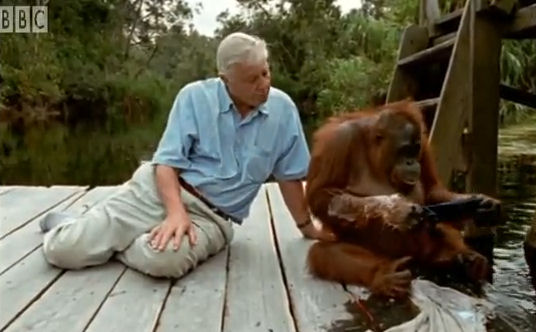 An orangutan washing socks with soap
An orangutan washing socks with soap © BBC Earth
One of the most interesting things about orangutans is, of course, their ability to imitate actions of others.
I have recently seen the most amusing example of this: an orangutan is washing a pair of socks with a bar of soap, with David Attenborough - a renowned British presenter - sitting by her side and admiring her intelligence.
Here is a image I have captured from this BBC Earth's video.
The presenter says that the orangutan did it totally on her own, simply by observing and copying actions of other individuals doing the same. No one trained her or taught her to do so - she did it totally on her own initiative.
We discuss Orangutans' Intelligence, including imitation, in more detail in our article here.
Orangutan as an Endangered Animal and Orangutan Conservation
... I would say, if nothing is done, orangutan populations outside of national parks have less than 10 years left.
~ Birute Galdikas (Ref. 49)
During the last several decades orangutans, like many other animals, have become so endangered that they may now be teetering on the brink of total disappearance.
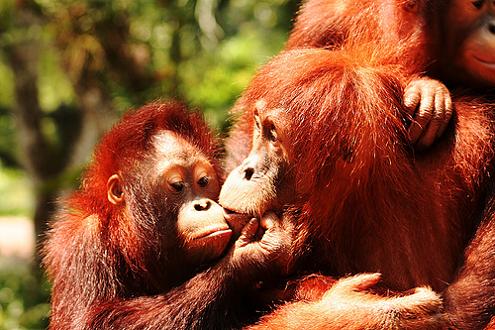 © Magnus von Koeller
© Magnus von Koeller
Experts say that if no real action is taken urgently to help orangutans survive, they may only have years left to live.
They used to live throughout Southeast Asia but now inhabit only the islands of Borneo and Sumatra.
At the start of the 20th century in Borneo alone there were 225,000 orangutans. (Ref. 50)
The estimates taken between 2000 and 2003 put the current population numbers of the Bornean orangutans (Pongo pygmaeus) at around 45,000 - 69,000 individuals; as of 2008, these numbers would be much lower. (Ref. 51)
The International Union for Conservation of Nature (IUCN) classifies the Bornean species as endangered. (Ref. 52)
The most recent 2004 estimate of populations of the Sumatran orangutans (Pongo abelii) puts their numbers at around 7,300 individuals.
IUCN classifies the Sumatran species as critically endangered. (Ref. 53)
So what has gone wrong for these animals and what can we do to protect them?
Again, as it is often the case with other endangered species, the major threats faced by orangutans are mostly those posed by their human counterparts.
We discuss these in detail below.
Threats Faced by Orangutans
Habitat Loss and Fragmentation
Habitat loss is certainly one of the main driving forces behind the recent decline in orangutan populations.
Orangutans need vast areas of forest to range, feed and reproduce. So even low rates of deforestation may affect their ability to do so according to their needs.
Jeffrey K. Mckee gives a good description of this situation: (Ref. 54)
Imagine losing this beauty to greed
© Pedro CabaOrangutans don't travel much in a given day, but over the course of time they forage across vast expanses to find the scarce and unpredictable fruits they rely on.
Like early foraging humans in many ways, they are quite clever at finding their food. They use their learned knowledge of the forest to track potential food resources, and can deduce the location of food by watching the movements of other animals.
But their odd social structure is what really cramps their ability to survive in fragmented habitats. The males are quite solitary most of the time, excepting "long erotic treetop trysts" with the females when they breed. ... The territories of the males overlap, but the whole habitat must allow suitable space for all the males to range and find an accepting partner for the tryst.
Habitat fragmentation thus hinders mating. Even if the males locate willing mates, the orangutans' slow reproduction rate exacerbates their diminished potential for resilience.
Their plight becomes increasingly difficult as fragmentation also aggravates intraspecific conflict. Although aggressive encounters between males competing for a partner have always occurred in this species, albeit largely vocal aggression, the frequency and violence of such encounters has increased as the available ranges become smaller and smaller.
Oil palm plantations, forest fires and illegal logging are the major causes of orangutans' habitat destruction and fragmentation.
Oil Palm Plantations and Forest Fires
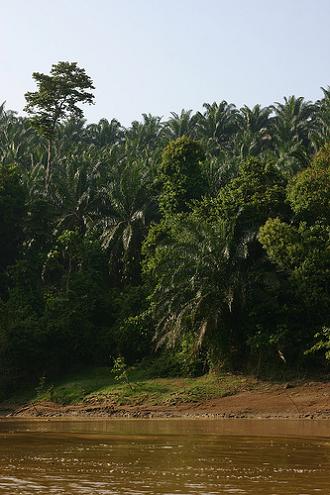 Oil Palm Plantation, Borneo
Oil Palm Plantation, Borneo Photo: Simon Taylor
The surge in the use of palm oil for anything from cooking to cosmetics to biofuels at the end of the 20th - beginning of the 21st century is a leading fundamental cause of the loss of orangutans' rainforest habitats.
Palm oil is produced from the fruit of oil palm trees mostly cultivated in Malaysia and Indonesia.
Oil palm plantations require large areas of suitable land which is always in scarce supply.
So rainforests are ruthlessly cleared to make space for these plantations.
The rates of rainforest clearance for these purposes are truly staggering.
For example, 87% (!) of all deforestation in Malaysia that took place between 1985 and 2000, was due to oil palm plantations. (Ref. 55)
And the methods "the agents" of rainforest destruction are choosing are not particularly environmentally-friendly either.
Apparently, the most "practical" method is by fires (ref. 56) which are usually started by those interested in cleared land, ex. plantation owners.
You may have heard about severe Indonesian fires of 1997 - 1998 which, at the time, were exacerbated by unusually dry conditions in the region.
We now know that "Borneo's orangutan population was reduced by one-third in just one year, 1997, when almost 8,000 orangutans were either burned to death or were massacred when they tried to escape fires." (Ref. 57)
Not even to mention the fact that fires contain a cocktail of toxins and are sources of air pollution which negatively affects human health as well.
Illegal Logging
Timber is a commodity that is in high international demand. This demand is driven by several growing economies, such as China.
Lowland dipterocarp forests which are preferred by Bornean orangutans are extremely valuable timber resources and are obviously targeted by illegal loggers.
As of 2007, illegal logging accounted for more than 73% of all logging in Indonesia, and orangutan habitat was being lost much faster than previously feared. (Ref. 58)
Hunting and Pet Trade
Hunting is another real danger to orangutan survival.
People hunt these rainforest animals for bushmeat trade, use of their body parts for traditional medicine, for pet trade.
As for pet trade, mothers are killed in the wild for their infants which are then exported to other countries. Another problem is that when infants grow into wild adults and become unmanageable, they are given up by their owners and become totally homeless.
Below is one of the most shocking examples when a significant number of orangutans became innocent victims of pet trade: (Ref. 59)
One of the most egregious episodes of ape-smuggling occurred in Taiwan during the late 1980s, when a popular Taiwanese television show featured a live orangutan as a main character.
The show led many viewers to want young orangutans as pets, and ape smugglers, with little to fear from Taiwan's poorly enforced wildlife protection laws, were happy to oblige.
As many as 1,000 orangutans may have illegally entered the country, and were subsequently sold through newspaper advertisements. That's the equivalent of 3 to 5 percent of the entire wild orangutan population. But the full toll was certainly far higher, since the capture of an infant primate invariably involves killing its mother, and many captured infants would have died in transit.
By the early 1990s, according to a recent World Wide Fund for Nature report, "the capital of Taiwan, Taipei, was reputed to have more orangutans per square kilometer than the species' natural habitat." Most of these orangutans have since been abandoned by their owners because they have matured and become unmanageable.
Spread of Viruses and Bacteria
As if they don't already have enough to deal with, orangutans' well-being may be further damaged by the spread of viruses and bacteria.
Biological similarities between orangutans and humans make it easy for orangutans to get infected with human diseases and then spread them among their species. This may particularly happen after orangutans' re-introduction into the wild as part of their rehabilitation programs. (Ref. 60)
This threat to orangutans may be further exacerbated by global warming which creates even warmer, more favorable conditions for the spread of infectious diseases (ref. 61) (also see global warming effects).
Other Risks
The low levels of genetic variation as a result of fewer remaining numbers of orangutan populations may also possibly point to weaker chances of their survival in the future.
Another hurdle may be the fact that female orangutans have very long intervals between breeding sessions - on average, they deliver only once every eight years.
These factors make conservation efforts even more challenging.
Saving the Orangutans
It is, of course, important that we do everything we can to save these endangered animals.
Environmental activists have been working for years trying to find efficient ways of protecting orangutans from the threats that they face.
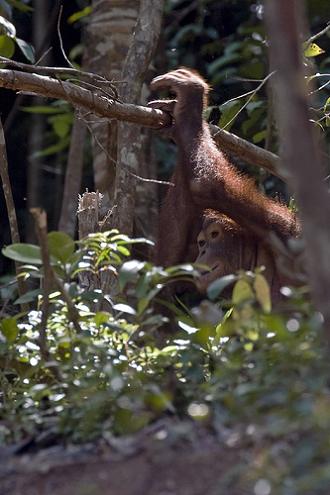 Photo: Iain Rendle
Photo: Iain Rendle
There are national parks created by governments, and rehabilitation centers created by private citizens - true enthusiasts of the nature. All being done for one purpose - prevention of potential extinction of orangutans in the wild.
Theoretically, the real solution to this issue will only come when there will be no demand for the products extracted unsustainably from the rainforests - palm oil, timber, orangutans as pets etc.
But before this dream comes true, there are many things that we can do as individuals. For example, we could:
- boycott products containing palm oil (though it is not always easy because many retailers name it as simply "vegetable oil" in their ingredient lists)
- support charities which put pressure on governments to develop and enforce environmentally friendly policies
- promote ecotourism as a way to raise funds for orangutan protection
- educate our families and friends about orangutans and the environment in general.
to name just a few.
Conclusion
Experts are sounding an alarm that if nothing is done to help these animals now, they may be totally gone in 10 years' time.
In other words, they may well be on the brink of extinction.
We know the root causes of their endangerment; we now need to find the ways to eliminate them and save these beautiful animals from extinction.
Written by: Irina Bright
Original publication date: 2009
Updates: 2013
Republication date: 2020
References
1. Taken from:
Goodman, A. H., Heath, D., & Lindee, M. S. (Eds.). (2003). Genetic Nature/Culture: Anthropology and Science beyond the Two-Culture Divide. Berkeley, CA: University of California Press, p. 148. Retrieved January 20, 2009 from Questia. com
2. Taken from:
Preece, R. (1999). Animals and Nature: Cultural Myths, Cultural Realities. Vancouver, B.C.: University of British Columbia Press, p. 149. Retrieved January 20, 2009 from Questia.com
3. Taken from:
Silverberg, R. (1964). Man before Adam: The Story of Man in Search of His Origins. Philadelphia: Macrae Smith, p. 51. Retrieved January 20, 2009 from Questia.com
4. Orangutan (2009). In Encyclopedia Britannica. Retrieved January 5, 2009 from Encyclopedia Britannica Online Library Edition: http://library.eb.co.uk/eb/article-9057273
5. An Appeal for the Apes Orangutans Are Dying by the Thousands as Habitat Is Destroyed. (October 19, 2007). Daily Herald (Arlington Heights, IL). Retrieved January 20, 2009 from Questia.com
6. Orangutan (2009). In Encyclopedia Britannica. Retrieved January 5, 2009 from Encyclopedia Britannica Online Library Edition: http://library.eb.co.uk/eb/article-9057273
7. Orangutan. (January 5, 2009). In Wikipedia, The Free Encyclopedia. Retrieved January 21, 2009 from http://en.wikipedia.org/w/index.php?title=Orangutan&oldid=262102643
8. Ibid.
9. Orangutan (2009). In Encyclopedia Britannica. Retrieved January 5, 2009 from Encyclopedia Britannica Online Library Edition: http://library.eb.co.uk/eb/article-9057273
10. Orangutan. (January 5, 2009). In Wikipedia, The Free Encyclopedia. Retrieved January 21, 2009 from http://en.wikipedia.org/w/index.php?title=Orangutan&oldid=262102643
11. Ibid.
12. Ibid.
13. Ibid.
14. Eckert, F. J. (September 7, 1997). Malaysia's Magical 'Wild East' Adventures: Exotic Sabah Lies off the Tourist Track. The Washington Times. Retrieved January 20, 2009 from Questia.com
15. Ibid.
16. Cawthon Lang KA. (June 13, 2005). Primate Factsheets: Orangutan (Pongo) Taxonomy, Morphology, & Ecology. Retrieved January 21, 2009 from http://pin.primate.wisc.edu/factsheets/entry/orangutan/taxon
17. Orangutan. (January 5, 2009). In Wikipedia, The Free Encyclopedia. Retrieved January 21, 2009 from http://en.wikipedia.org/w/index.php?title=Orangutan&oldid=262102643
18. Honolulu Zoo (2008). Orangutan. Retrieved January 21, 2009 from http://www.honoluluzoo.org/orangutan.htm
19. Ibid.
20. Cawthon Lang KA. (June 13, 2005). Primate Factsheets: Orangutan (Pongo) Taxonomy, Morphology, & Ecology. Retrieved January 21, 2009 from http://pin.primate.wisc.edu/factsheets/entry/orangutan/taxon
21. Honolulu Zoo (2008). Orangutan. Retrieved January 21, 2009 from http://www.honoluluzoo.org/orangutan.htm
22. Cawthon Lang KA. (June 13, 2005). Primate Factsheets: Orangutan (Pongo) Taxonomy, Morphology, & Ecology. Retrieved January 21, 2009 from http://pin.primate.wisc.edu/factsheets/entry/orangutan/taxon
23. Ibid.
24. Ibid.
25. Ibid.
26. Orangutan. (January 5, 2009). In Wikipedia, The Free Encyclopedia. Retrieved January 21, 2009 from http://en.wikipedia.org/w/index.php?title=Orangutan&oldid=262102643
27. Orangutan (2009). In Encyclopedia Britannica. Retrieved January 5, 2009 from Encyclopedia Britannica Online Library Edition: http://library.eb.co.uk/eb/article-9057273
28. Cawthon Lang KA. (June 13, 2005). Primate Factsheets: Orangutan (Pongo) Taxonomy, Morphology, & Ecology. Retrieved January 21, 2009 from http://pin.primate.wisc.edu/factsheets/entry/orangutan/taxon
29. Orangutan. (January 5, 2009). In Wikipedia, The Free Encyclopedia. Retrieved January 21, 2009 from http://en.wikipedia.org/w/index.php?title=Orangutan&oldid=262102643
30. Honolulu Zoo (2008). Orangutan. Retrieved January 21, 2009 from http://www.honoluluzoo.org/orangutan.htm
31. Cawthon Lang KA. (June 13, 2005). Primate Factsheets: Orangutan (Pongo) Taxonomy, Morphology, & Ecology. Retrieved January 21, 2009 from http://pin.primate.wisc.edu/factsheets/entry/orangutan/taxon
32. Orangutan. (January 5, 2009). In Wikipedia, The Free Encyclopedia. Retrieved January 21, 2009 from http://en.wikipedia.org/w/index.php?title=Orangutan&oldid=262102643
33. Main references for this section are:
Cawthon Lang KA. (June 13, 2005). Primate Factsheets: Orangutan (Pongo) Taxonomy, Morphology, & Ecology. Retrieved January 21, 2009 from http://pin.primate.wisc.edu/factsheets/entry/orangutan/taxon
Honolulu Zoo (2008). Orangutan. Retrieved January 21, 2009 from http://www.honoluluzoo.org/orangutan.htm
Orangutan Outreach (2009). About Orangutans. Retrieved January 21, 2009 from http://redapes.org/orangutans/
34. Main references for this section are:
Cawthon Lang KA. (June 13, 2005). Primate Factsheets: Orangutan (Pongo) Behavior. Retrieved January 21, 2009 from http://pin.primate.wisc.edu/factsheets/entry/orangutan/behav
Cawthon Lang KA. (June 13, 2005). Primate Factsheets: Orangutan (Pongo) Taxonomy, Morphology, & Ecology. Retrieved January 21, 2009 from http://pin.primate.wisc.edu/factsheets/entry/orangutan/taxon
Orangutan (2009). In Encyclopedia Britannica. Retrieved January 5, 2009 from Encyclopedia Britannica Online Library Edition: http://library.eb.co.uk/eb/article-9057273
Honolulu Zoo (2008). Orangutan. Retrieved January 21, 2009 from http://www.honoluluzoo.org/orangutan.htm
35. Ancrenaz, M., Marshall, A., Goossens, B., van Schaik, C., Sugardjito, J., Gumal, M. & Wich, S. 2008. Pongo pygmaeus. In: IUCN 2008. 2008 IUCN Red List of Threatened Species. Retrieved December 14, 2008 from http://www.iucnredlist.org/details/17975.
36. Orangutan. (January 5, 2009). In Wikipedia, The Free Encyclopedia. Retrieved January 21, 2009 from http://en.wikipedia.org/w/index.php?title=Orangutan&oldid=262102643
37. Main references for this section are:
Cawthon Lang KA. (June 13, 2005). Primate Factsheets: Orangutan (Pongo) Behavior. Retrieved January 21, 2009 from http://pin.primate.wisc.edu/factsheets/entry/orangutan/behav
Orangutan (2009). In Encyclopedia Britannica. Retrieved January 5, 2009 from Encyclopedia Britannica Online Library Edition: http://library.eb.co.uk/eb/article-9057273
38. Orangutan. (January 5, 2009). In Wikipedia, The Free Encyclopedia. Retrieved January 21, 2009 from http://en.wikipedia.org/w/index.php?title=Orangutan&oldid=262102643
39. Ibid.
40. Eckert, F. J. (September 7, 1997). Malaysia's Magical 'Wild East' Adventures: Exotic Sabah Lies off the Tourist Track. The Washington Times. Retrieved January 20, 2009 from Questia.com
41. Julia of the Jungle; JULIA ROBERTS Has Portrayed Many Tender Stories on the Silver Screen. but, She Reveals Her Deepest Passions Were Stirred When She Travelled to the Steamy Forests of Borneo to Meet a Giant Orang-Utan, Who Held Her in His Huge Hands - but Was Too Gentle to Hurt Her. (October 15, 2005). The Daily Mail (London, England). Retrieved January 20, 2009 from Questia.com
42. Kolber, A. (2001). Standing Upright: The Moral and Legal Standing of Humans and Other Apes. Stanford Law Review, Vol. 54. Retrieved January 20, 2009 from Questia.com
43. Byrne, R. R. (1995). The Thinking Ape: Evolutionary Origins of Intelligence. Oxford: Oxford University Press, p. 114. Retrieved January 20, 2009 from Questia.com
44. Ibid, p. 183
45. Cawthon Lang KA. (June 13, 2005). Primate Factsheets: Orangutan (Pongo) Behavior. Retrieved January 21, 2009 from http://pin.primate.wisc.edu/factsheets/entry/orangutan/behav
46. Ibid.
47. Chantek. (December 7, 2008). In Wikipedia, The Free Encyclopedia. Retrieved January 21, 2009 from http://en.wikipedia.org/w/index.php?title=Chantek&oldid=256372464
48. Kolber, A. (2001). Standing Upright: The Moral and Legal Standing of Humans and Other Apes. Stanford Law Review, Vol. 54. Retrieved January 20, 2009 from Questia.com
49. McDowell, R. (2009). Palm oil frenzy threatens to wipe out orangutans. Associated Press via Yahoo! News. Retrieved January 21, 2009 from http://news.yahoo.com/s/ap/20090118/ap_on_re_as/as_orangutan_s_last_stand
50. An Appeal for the Apes Orangutans Are Dying by the Thousands as Habitat Is Destroyed. (October 19, 2007). Daily Herald (Arlington Heights, IL). Retrieved February 17, 2009 from Questia.com
51. Ancrenaz, M., Marshall, A., Goossens, B., van Schaik, C., Sugardjito, J., Gumal, M. & Wich, S. 2008. Pongo pygmaeus. In: IUCN 2008. 2008 IUCN Red List of Threatened Species. Retrieved February 14, 2009 from http://www.iucnredlist.org/
52. Ibid.
53. Singleton, I., Wich, S.A. & Griffiths, M. 2008. Pongo abelii. In: IUCN 2008. 2008 IUCN Red List of Threatened Species. Retrieved February 14, 2009 from http://www.iucnredlist.org/
54. Mckee, J. K. (2003). Sparing Nature: The Conflict between Human Population Growth and Earth's Biodiversity, pp. 115 - 116. New Brunswick, NJ: Rutgers University Press. Retrieved February 17, 2009 from Questia.com
55. Augustyn, H. (July/August, 2007). A Burning Issue: Palm Oil Shows Promise as a Biofuel, but the Environmental Cost of Production Can Be High. World Watch, Vol. 20. Retrieved February 17, 2009 from Questia.com
56. Ibid.
57. Ibid.
58. Wallis, D. (February 7, 2007). Illegal Logging Hits Asian Forests, Orangutans - UN. Reuters via Planet Ark. Retrieved February 17, 2009 from http://www.planetark.com/dailynewsstory.cfm/newsid/40222/story.htm
59. Tuxill, J. (September/October, 1997). The Global Decline of Primates. World Watch, Vol. 10. Retrieved February 17, 2009 from Questia.com
60. Mckee, J. K. (2003). Sparing Nature: The Conflict between Human Population Growth and Earth's Biodiversity, p. 121. New Brunswick, NJ: Rutgers University Press. Retrieved February 17, 2009 from Questia.com
61. Ibid., pp. 129 - 130